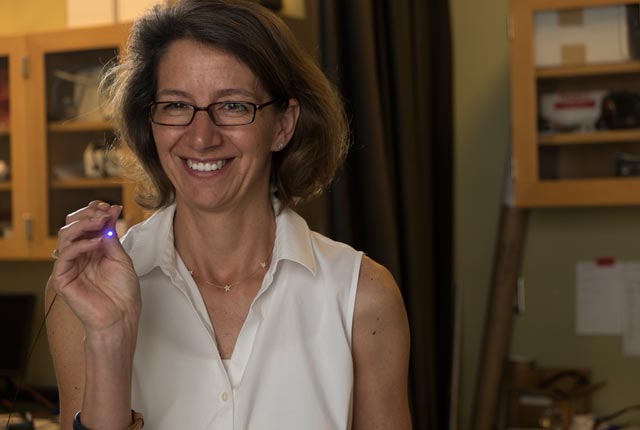David Ruth
713-348-6327
david@rice.edu
Jade Boyd
713-348-6778
jadeboyd@rice.edu
Imaging software could speed breast cancer diagnosis
Technology could improve access to diagnostic services in developing countries
HOUSTON — (Aug. 21, 2015) — New software developed by Rice University bioengineers could speed up the diagnosis of breast cancer with 90 percent accuracy and without the need for a specialist, according to research published this week in the open-access journal Breast Cancer Research.
Researchers said the software could improve breast cancer management, particularly in developing countries where pathologists are not routinely available.

Rebecca Richards-Kortum
“To evaluate fresh breast tissue at the point of care could change the current practice of pathology,” said lead researcher Rebecca Richards-Kortum, Rice’s Malcolm Gillis University Professor and professor of bioengineering and of electrical and computer engineering. “We have developed a faster means to classify benign and malignant human breast tissues using fresh samples and thereby removing the need for time-consuming tissue preparation.”
Today, breast-cancer diagnosis is an intricate process. Tissue first must be obtained, typically by either a core needle biopsy or surgical excision. Next, pathologists must complete a complex process to prepare the tissue for analysis and histological assessment.
When examined under a microscope, cancerous and precancerous cells typically appear different from healthy cells. The study of cellular structures is known as histology, and a histological analysis is typically required for an accurate diagnosis of both the type and stage of a cancerous tumor.
The software developed in Richards-Kortum’s lab allows for an automated histological assessment of breast cancer from tissue samples without the need for complex tissue-sample preparation or assessment by a pathologist. The software uses high-speed optical microscopy of intact breast tissue specimens.
“We performed our analysis without tissue fixation, cutting and staining and achieved comparable classification with current methods,” Richards-Kortum said. “This cuts out the tissue-preparation process and allows for rapid diagnosis. It is also reliant on measurable criteria, which could reduce subjectivity in the evaluation of breast histology.”
The software uses images from a confocal fluorescence microscope to analyze freshly cut human breast tissue samples for certain histological parameters that are typically used in breast cancer diagnosis. The software uses the parameter data to classify the tissue in each image and make a determination whether the imaged tissue is benign or malignant.
Although the software could have substantial clinical relevance, Richards-Kortum said more research and refinement of the classification procedures are needed before the software can be used in a clinical setting.
Rice graduate student Jessica Dobbs, the study’s lead author, said, “We are excited about the possibility of using these imaging techniques to improve access to histologic diagnosis in developing regions that lack the human resources and equipment necessary to perform standard histologic assessment.”
-30-
A high-resolution IMAGE is available for download at:
https://news2.rice.edu/files/2015/05/0601_HRME-5-web.jpg
CAPTION: Rebecca Richards-Kortum
CREDIT: Jeff Fitlow/Rice University
A copy of the Breast Cancer Research paper is available at:
http://www.breast-cancer-research.com/content/17/1/105
Located on a 300-acre forested campus in Houston, Rice University is consistently ranked among the nation’s top 20 universities by U.S. News & World Report. Rice has highly respected schools of Architecture, Business, Continuing Studies, Engineering, Humanities, Music, Natural Sciences and Social Sciences and is home to the Baker Institute for Public Policy. With 3,888 undergraduates and 2,610 graduate students, Rice’s undergraduate student-to-faculty ratio is 6-to-1. Its residential college system builds close-knit communities and lifelong friendships, just one reason why Rice is ranked No. 1 for best quality of life and for lots of race/class interaction by the Princeton Review. Rice is also rated as a best value among private universities by Kiplinger’s Personal Finance. To read “What they’re saying about Rice,” go here.

